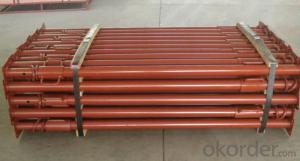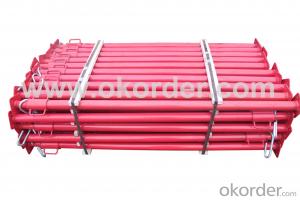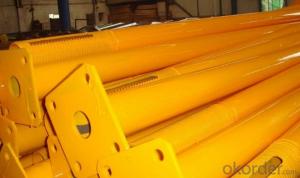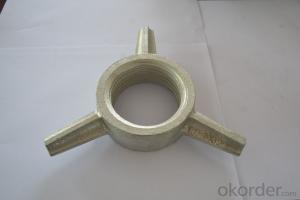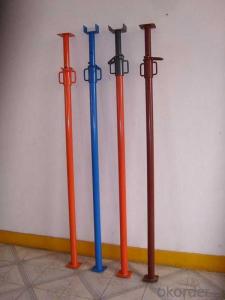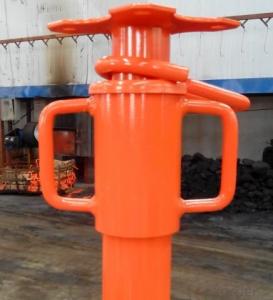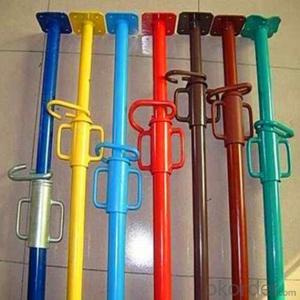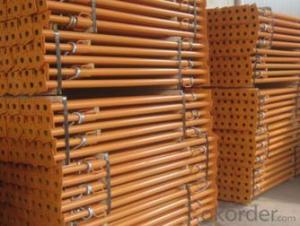telescopic props scaffolding props steel props
- Loading Port:
- China Main Port
- Payment Terms:
- TT OR LC
- Min Order Qty:
- -
- Supply Capability:
- -
OKorder Service Pledge
OKorder Financial Service
You Might Also Like
Quick Details
| Model Number: | |||||
| Type: | Scaffolding Part Type: | Material: | |||
| Surface treatment: | Color: | Technique: | |||
| Length: | Inner tube diameter: | Outer tube diameter: | |||
| Thickness: | Application: | Certification: |
Packaging & Delivery
| Packaging Detail: | 1.props scaffolding props steel props is in a bundle with a wire which is in bare package. 2.One 20 GP container can load almost 1500-2000 pieces of props. |
| Delivery Detail: | 10-20 days after deposit |
Specifications
props scaffolding props steel props
1.For slab supporting
2.CO2 arc welded technique
3.High loading capacity
4.Rust-proof
Features
1. One pieces of props scaffolding props steel props consists of internal tube, external tube, prop nut, base plate, and top plate.
2. props scaffolding props steel props can be adjusted to any length within its range which is convenient for using.
3.With its simple structure, props scaffolding props steel props is easy to assemble and dismantle which can help to save your time, labor, and cost.
4.We have several kinds of props scaffolding props steel props which are Middle East type props scaffolding props steel props , Spanish props scaffolding props steel props and Italian type props scaffolding props steel props . They are popular in Africa,South America,South Asia, and Asia etc.
5. props scaffolding props steel props is for supporting concrete slab, beam, timber, and formwork which is strong and reliable for interior building construction.
6.We can weld the flat plate or the flower plate at the top of the props scaffolding props steel props as your requirement.
SpecificationsChina)
| Product | Model | Specifications |
props scaffolding props steel props | Inner tube diameter |
40/48mm |
| Outer tube diameter |
48/56/60mm | |
| Tube thickness |
1.8/2.0/2.2/2.5/3mm | |
| Adjustable length | 1600-2900mm 1800-3200mm 2000-3600mm 2200-4000mm |
- Q:Can steel props be used for temporary support in power plant construction?
- Yes, steel props can be used for temporary support in power plant construction. Steel props are adjustable and can provide strong support for temporary structures during construction. They are commonly used in various construction projects, including power plant construction, to provide temporary support to formwork, scaffolding, or other structures. Steel props are known for their high load-bearing capacity, stability, and durability, making them suitable for supporting heavy loads and ensuring the safety and stability of temporary structures during power plant construction.
- Q:Are steel props resistant to impact or vibration?
- Both impact and vibration are generally resisted by steel props. Due to its strength and durability, steel is able to endure substantial impact forces without any harm. Furthermore, steel possesses a high natural frequency, enabling it to efficiently absorb and disperse vibrations. Consequently, steel props are deemed highly suitable for situations where resistance to impact and vibration is crucial, such as in construction, scaffolding, and temporary support structures. Nevertheless, it is important to acknowledge that the precise impact and vibration resistance of steel props may differ based on their individual design, quality, and installation.
- Q:What are the alternatives to using steel props?
- There are several alternatives to using steel props in construction and supporting structures. Some of the commonly used alternatives include: 1. Aluminum Props: Aluminum props are lightweight and easy to handle, making them a popular choice for temporary support in construction projects. They offer high load-bearing capacity and can be adjusted to different heights. Additionally, aluminum props are resistant to corrosion, making them suitable for outdoor use. 2. Timber Props: Timber props, also known as wooden props, are a traditional alternative to steel props. They are cost-effective, readily available, and easy to install. Timber props are often used in smaller construction projects or where temporary support is required. However, they may not offer the same load-bearing capacity as steel props. 3. Adjustable Telescopic Props: These props are made of a combination of materials such as aluminum, timber, or composite materials. They consist of extendable sections that can be adjusted to different heights, offering versatility in various construction applications. Adjustable telescopic props are lightweight, easy to handle, and provide reliable support. 4. Hydraulic Props: Hydraulic props use hydraulic pressure to provide support. They are typically used in mining operations or situations where heavy loads need to be supported. Hydraulic props offer the advantage of being able to withstand high loads and can be easily adjusted for height. However, they require specialized equipment and skilled operators to operate effectively. 5. Composite Props: Composite props are made from a combination of materials such as fiberglass, carbon fiber, or reinforced polymers. They offer high strength-to-weight ratios, making them ideal for applications where lightweight support is required. Composite props are resistant to corrosion and can withstand heavy loads, but they may be more expensive than other alternatives. It is important to consider the specific requirements of the project, such as load capacity, duration of support, and environmental conditions, when choosing an alternative to steel props. Consulting with a structural engineer or construction professional can help in selecting the most suitable alternative for a particular project.
- Q:Can steel props be used in road construction?
- Road construction often involves the use of steel props. These props, also known as adjustable steel props or acrow props, are commonly employed in the construction industry to provide temporary support and hold structures or formwork during projects. When it comes to road construction, steel props are frequently utilized to stabilize and support temporary structures like scaffolding, formwork, or concrete barriers. They are also relied upon to offer additional support to excavated areas or trenches during the creation of road foundations or underground utilities. The preference for steel props in road construction arises from their strength, durability, and adjustability. They can easily be adjusted to the required height, providing flexibility in various construction scenarios. Furthermore, steel props are lightweight and portable, which contributes to their efficiency and cost-effectiveness in road construction endeavors. In addition, steel props boast a high load-bearing capacity, ensuring the stability and safety of construction sites. They are capable of withstanding heavy loads and offering reliable support to the structures and formwork employed in road construction. Overall, steel props are a valuable asset in road construction as they offer temporary support and stability to a range of structures and formwork used throughout the construction process.
- Q:How do you prevent steel props from sliding on icy surfaces?
- To prevent steel props from sliding on icy surfaces, there are several measures you can take: 1. Use anti-slip mats or grips: Place rubber or anti-slip mats underneath the steel props to provide traction and prevent them from sliding. These mats are designed to grip onto the icy surface and create friction, ensuring stability. 2. Secure props with straps or clamps: Use straps or clamps to secure the steel props to nearby structures, such as walls or poles. This will help stabilize the props and prevent them from sliding on the icy surface. 3. Add weight or ballast: Increasing the weight on the steel props can improve stability and reduce the likelihood of sliding. You can attach additional weights to the props or use sandbags as ballast to anchor them down. 4. Create a stable base: Clear any snow or ice from the ground where the steel props will be placed. Level the surface and ensure it is free from any debris that could affect stability. If possible, create a stable base by using plywood or other flat materials to provide a solid foundation for the props. 5. Use ice melt or traction aids: Apply ice melt or other traction aids to the surface around and underneath the steel props. These substances can help melt the ice and improve grip, reducing the chances of sliding. 6. Monitor and maintain: Regularly inspect the props and the surrounding area for any signs of movement or instability. If necessary, readjust the props, add more traction aids, or reinforce the stability measures to maintain a secure setup. It is crucial to prioritize safety and take necessary precautions when working with steel props on icy surfaces. By implementing these preventive measures, you can minimize the risk of sliding and ensure a stable and secure setup.
- Q:Can steel props be used in the construction of historical monuments?
- Yes, steel props can be used in the construction of historical monuments. Steel props are commonly used in construction projects to provide temporary support to structures during renovation or restoration work. These props can be adjusted to the desired height and are known for their strength and stability, making them suitable for supporting historical monuments. When it comes to historical monuments, the preservation of their original structure is of utmost importance. Steel props can be strategically placed to provide support to weak or damaged areas while the necessary repairs or restoration work is being carried out. These props can help distribute the weight and provide additional stability to the structure, ensuring that any potential risks are minimized. Furthermore, steel props offer versatility in terms of size and adjustability, allowing them to be easily customized to fit the specific needs of each historical monument. They can be used to reinforce fragile sections, temporarily hold up walls or ceilings, or support delicate architectural features during construction or restoration processes. However, it is crucial to ensure that the use of steel props does not compromise the authenticity and historical integrity of the monument. Proper planning and consultation with experts in historical preservation are essential to ensure that the use of steel props is done in a way that respects and preserves the monument's original design and materials. In conclusion, steel props can be utilized in the construction of historical monuments to provide temporary support during renovation or restoration work. Their strength, adjustability, and versatility make them a suitable choice for reinforcing weak or damaged areas while preserving the monument's historical integrity.
- Q:Are steel props suitable for supporting temporary walkways or catwalks?
- Temporary walkways or catwalks can be effectively supported by steel props. These props, also referred to as scaffolding props, consist of adjustable steel tubes that are utilized for supporting various structures during construction or maintenance tasks. Their purpose is to ensure stability and the ability to bear loads, making them the perfect choice for temporary walkways or catwalks. There are numerous advantages associated with the use of steel props for this particular purpose. Primarily, they are incredibly easy to install and can be adjusted to the desired height, providing a stable platform for individuals to walk on. The adjustability feature allows for the props to be utilized in different heights and configurations, ensuring a level and safe walkway or catwalk. Moreover, steel props are renowned for their strength and durability. They possess the capability to withstand heavy loads and support the weight of multiple individuals simultaneously. This aspect renders them suitable for supporting temporary walkways or catwalks, where safety and stability are of utmost significance. Additionally, the versatility of steel props enables them to be used in various construction applications. They can be effortlessly combined with other scaffolding components to create a reliable and secure structure. This adaptability makes steel props a popular choice for temporary walkways or catwalks, as they can be customized to meet different requirements and site conditions. To summarize, steel props are indeed suitable for supporting temporary walkways or catwalks. Their adjustability, strength, and versatility make them an excellent option for establishing secure and stable platforms for individuals to utilize during construction or maintenance projects.
- Q:Can steel props be used for temporary support during roofing work?
- Indeed, temporary support during roofing work can be achieved by utilizing steel props. These adjustable and telescopic support systems are frequently employed in the construction industry to offer temporary support to structures or components. Designed to endure substantial loads and ensure stability, they are highly suitable for supporting roofing structures during repair or installation tasks. Thanks to their ease of adjustment and locking mechanism, steel props can effortlessly be set to the desired height, providing a secure and dependable support system for the entirety of the roofing work. Moreover, steel props possess versatility and can be applied in a multitude of construction scenarios, making them an ideal option for temporary support during roofing projects.
- Q:How do you determine the correct size of a steel prop for a specific application?
- Several factors must be taken into account when determining the appropriate size of a steel prop for a specific application. First and foremost, it is crucial to evaluate the load-bearing capacity needed for the particular use. This entails calculating the weight and force that the steel prop will bear. Considerations include the weight of the materials being supported, the distance between the props, and any additional loads or forces that will be applied. Furthermore, the height or vertical distance that the prop needs to support plays a vital role in determining its size. For taller heights, longer props may be necessary to ensure adequate stability and support. Another crucial factor to consider is the type of steel used in the prop. Different grades of steel possess varying load-bearing capacities and durability. It is important to consult industry standards and guidelines to select the appropriate grade for the specific application. Moreover, it is essential to take into account local building codes and regulations. These regulations may impose specific requirements or limitations on the use of props, including maximum weight capacities or minimum safety factors. Compliance with these regulations is vital to ensure the safety and structural integrity of the application. In conclusion, determining the correct size of a steel prop for a specific application requires considering the load-bearing capacity, the height to be supported, the grade of steel used, and compliance with local building codes and regulations. Consulting industry standards and guidelines, and seeking professional advice if necessary, can help ensure the correct size is determined for a safe and successful application.
- Q:What are the main considerations when using steel props for supporting temporary ramps?
- When using steel props for supporting temporary ramps, the main considerations include the weight-bearing capacity of the props, the stability of the props and ramp structure, proper placement and alignment of the props, and ensuring that the props are securely and adequately braced to prevent any movement or collapse during use. Additionally, it is essential to follow the manufacturer's guidelines and any relevant safety regulations to ensure the safe and effective use of steel props for supporting temporary ramps.
1. Manufacturer Overview |
|
|---|---|
| Location | |
| Year Established | |
| Annual Output Value | |
| Main Markets | |
| Company Certifications | |
2. Manufacturer Certificates |
|
|---|---|
| a) Certification Name | |
| Range | |
| Reference | |
| Validity Period | |
3. Manufacturer Capability |
|
|---|---|
| a)Trade Capacity | |
| Nearest Port | |
| Export Percentage | |
| No.of Employees in Trade Department | |
| Language Spoken: | |
| b)Factory Information | |
| Factory Size: | |
| No. of Production Lines | |
| Contract Manufacturing | |
| Product Price Range | |
Send your message to us
telescopic props scaffolding props steel props
- Loading Port:
- China Main Port
- Payment Terms:
- TT OR LC
- Min Order Qty:
- -
- Supply Capability:
- -
OKorder Service Pledge
OKorder Financial Service
Similar products
New products
Hot products
Hot Searches
Related keywords
